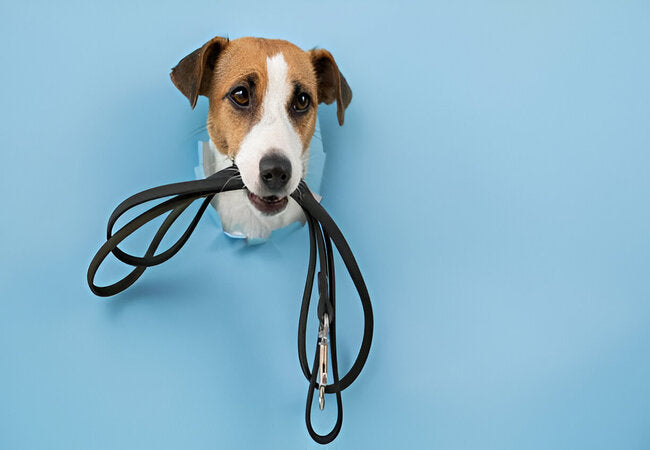Understanding Leash Reactivity in Dogs: Vet-Approved 2025 Solutions 🐶🛡️

In this article
Understanding Leash Reactivity in Dogs: Vet‑Approved 2025 Solutions 🐶🛡️
By Dr. Duncan Houston BVSc
Is your dog barking, lunging, or growling at other dogs, people, bikes, or cars—only *on leash*? That's leash reactivity. It’s common, stressful for both dog and owner, but entirely manageable. In this 2025 vet-approved guide, I explain root causes—like fear, frustration, and barrier aggression—and share a comprehensive, reward-based rehab plan: buffer zones, counter-conditioning, training, equipment, and when to involve your vet or behaviorist. Let’s help you enjoy calm, confident walks together! 🐾❤️
🧠 What Is Leash Reactivity?
Leash reactivity occurs when a dog exhibits fear or frustration *while leashed*, such as barking, lunging, growling, or snapping—even if they behave well off-leash. The leash removes their ability to escape or greet, increasing stress.
🚩 Common Triggers Explained
- Fear & anxiety: A Tight leash + an approaching stranger/dog can feel threatening.
- Frustration: Barrier frustration: seeing but not reaching a trigger causes intense emotional response.
- Lack of natural greetings: Leashed direct approaches mimic threatening behavior, confusing canine communication.
- Predatory/prey drive: Reactivity to moving objects like cars, bikes, squirrels.
- Past trauma: Previous negative leash experiences like punishments, exacerbate reactivity.
👀 Spot the Signs Early
Pre-reaction body language can include:
- Stiff posture, raised hackles, intense focus
- Growling, barking, and lunging behaviors
- Pacing, whining, pulling on leash
- Fixation on the trigger with inability to disengage
✔️ Why Leash Reactivity Needs Attention
Unmanaged leash reactivity can escalate into aggression, cause injury, or limit walks. It’s critical to intervene with structured behavior modification.
🔧 Vet-Approved Training Strategy
1. Use a Buffer Zone
Identify the distance at which your dog notices the trigger but remains calm. Stay just outside that zone each walk.
2. Counter-Conditioning
While walking at a safe distance, mark (“yes” or click) the instant your dog notices the trigger and reward with high-value treats. Repeat until triggers predict treats instead of stress.
3. "Look at That" (LAT) Training
Encourage your dog to glance at the trigger, then look back and receive a treat. Reward attention shifts repeatedly to build a positive association.
4. Gradual Distance Reduction
Slowly decrease the buffer over weeks/months, only when your dog remains relaxed and responsive.
5. Management & Equipment
- Use a non-retractable 4–6 ft leash, front-clip harness, or head collar to reduce pulling and increase control.
- Avoid punitive tools (choke collars/prongs)—they worsen anxiety and reactivity.
- Be a "defensive driver": cross the street or change direction before reactions begin.
6. Practice Engagement & Obedience
Teach reliable “look,” “come,” or “heel.” Practice these cues during low-pressure times to build trust and control in reactive moments.
7. Desensitization
In addition to live exposure, use audio/visual triggers (video of dogs, recording of approaching bikes) at home paired with rewards to build calm behavior.
8. Professional Support
If progress stalls—or there's aggression—consult a veterinary behaviorist or certified trainer. Medication may be beneficial in severe cases.
📋 Step-by-Step Walk Overview
| Phase | Focus | Tools |
|---|---|---|
| Preparation | Identify triggers, buffer zone, and rewards | Leash, treats, clicker |
| Awareness | Catch calm before reaction | Mark & reward |
| Engagement | LAT game → focus shift | “Look” cue + treats |
| Exposure | Slowly reduce the distance | Repetition + calm pacing |
| Management | Create a safe walking environment | Leash tools, avoid stressors |
| Support | Consult professionals if needed | Behaviorist, vet care |
🐕 Insights from Other Owners
> “Avoid avoid avoid – best reaction control is prevention.” > “Sounds like practicing impulse control at thresholds… structure and boundaries helps set the groundwork.”
🧩 Putting It All Together
- Start by minimizing stressors and teaching basic cues.
- Use buffer zones and reward-based counter-conditioning.
- Continue with LAT training and slowly increase exposure.
- Leverage proper equipment for safety and control.
- Consult behavior specialists when needed.
- Maintain consistent practice—even after improvements—to prevent relapse.
📱 Ask A Vet 2025 Support
Need guidance? Use the Ask A Vet app to:
- Upload videos of reactive episodes for tailored feedback
- Get advice on treatment types, training exercises, or medical evaluation
- Coordinate with your vet and trainer seamlessly
Your dedicated support system for every walk, every milestone. 🐾📲
❤️ Final Thoughts
Leash reactivity doesn’t mean your dog is aggressive—it’s a stress response. With patience, clear structure, positive training, and professional support, most dogs can learn to walk calmly and confidently on a leash. In 2025, this rehab approach is kinder, smarter, and more effective than ever. Every step you take together builds trust, resilience, and joy. 🚶♂️🐶❤️
Need tailored advice? Visit AskAVet.com or download the Ask A Vet app for 24/7 vet and behaviorist support.






